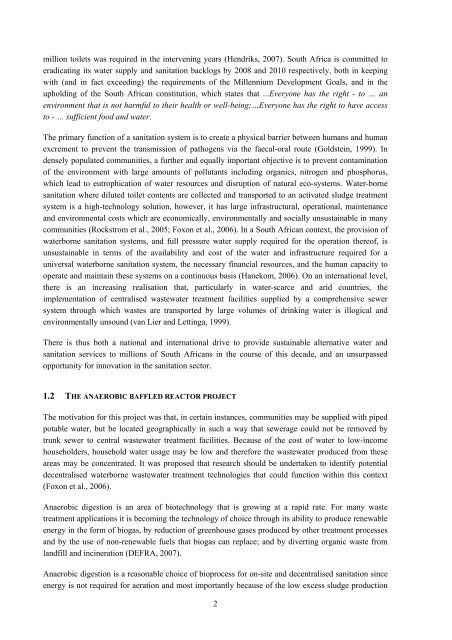analysis of a pilot-scale anaerobic baffled reactor treating domestic ...
analysis of a pilot-scale anaerobic baffled reactor treating domestic ...
analysis of a pilot-scale anaerobic baffled reactor treating domestic ...
Create successful ePaper yourself
Turn your PDF publications into a flip-book with our unique Google optimized e-Paper software.
million toilets was required in the intervening years (Hendriks, 2007). South Africa is committed to<br />
eradicating its water supply and sanitation backlogs by 2008 and 2010 respectively, both in keeping<br />
with (and in fact exceeding) the requirements <strong>of</strong> the Millennium Development Goals, and in the<br />
upholding <strong>of</strong> the South African constitution, which states that ...Everyone has the right - to … an<br />
environment that is not harmful to their health or well-being;…Everyone has the right to have access<br />
to - … sufficient food and water.<br />
The primary function <strong>of</strong> a sanitation system is to create a physical barrier between humans and human<br />
excrement to prevent the transmission <strong>of</strong> pathogens via the faecal-oral route (Goldstein, 1999). In<br />
densely populated communities, a further and equally important objective is to prevent contamination<br />
<strong>of</strong> the environment with large amounts <strong>of</strong> pollutants including organics, nitrogen and phosphorus,<br />
which lead to eutrophication <strong>of</strong> water resources and disruption <strong>of</strong> natural eco-systems. Water-borne<br />
sanitation where diluted toilet contents are collected and transported to an activated sludge treatment<br />
system is a high-technology solution, however, it has large infrastructural, operational, maintenance<br />
and environmental costs which are economically, environmentally and socially unsustainable in many<br />
communities (Rockstrom et al., 2005; Foxon et al., 2006). In a South African context, the provision <strong>of</strong><br />
waterborne sanitation systems, and full pressure water supply required for the operation there<strong>of</strong>, is<br />
unsustainable in terms <strong>of</strong> the availability and cost <strong>of</strong> the water and infrastructure required for a<br />
universal waterborne sanitation system, the necessary financial resources, and the human capacity to<br />
operate and maintain these systems on a continuous basis (Hanekom, 2006). On an international level,<br />
there is an increasing realisation that, particularly in water-scarce and arid countries, the<br />
implementation <strong>of</strong> centralised wastewater treatment facilities supplied by a comprehensive sewer<br />
system through which wastes are transported by large volumes <strong>of</strong> drinking water is illogical and<br />
environmentally unsound (van Lier and Lettinga, 1999).<br />
There is thus both a national and international drive to provide sustainable alternative water and<br />
sanitation services to millions <strong>of</strong> South Africans in the course <strong>of</strong> this decade, and an unsurpassed<br />
opportunity for innovation in the sanitation sector.<br />
1.2 THE ANAEROBIC BAFFLED REACTOR PROJECT<br />
The motivation for this project was that, in certain instances, communities may be supplied with piped<br />
potable water, but be located geographically in such a way that sewerage could not be removed by<br />
trunk sewer to central wastewater treatment facilities. Because <strong>of</strong> the cost <strong>of</strong> water to low-income<br />
householders, household water usage may be low and therefore the wastewater produced from these<br />
areas may be concentrated. It was proposed that research should be undertaken to identify potential<br />
decentralised waterborne wastewater treatment technologies that could function within this context<br />
(Foxon et al., 2006).<br />
Anaerobic digestion is an area <strong>of</strong> biotechnology that is growing at a rapid rate. For many waste<br />
treatment applications it is becoming the technology <strong>of</strong> choice through its ability to produce renewable<br />
energy in the form <strong>of</strong> biogas, by reduction <strong>of</strong> greenhouse gases produced by other treatment processes<br />
and by the use <strong>of</strong> non-renewable fuels that biogas can replace; and by diverting organic waste from<br />
landfill and incineration (DEFRA, 2007).<br />
Anaerobic digestion is a reasonable choice <strong>of</strong> bioprocess for on-site and decentralised sanitation since<br />
energy is not required for aeration and most importantly because <strong>of</strong> the low excess sludge production<br />
2
















